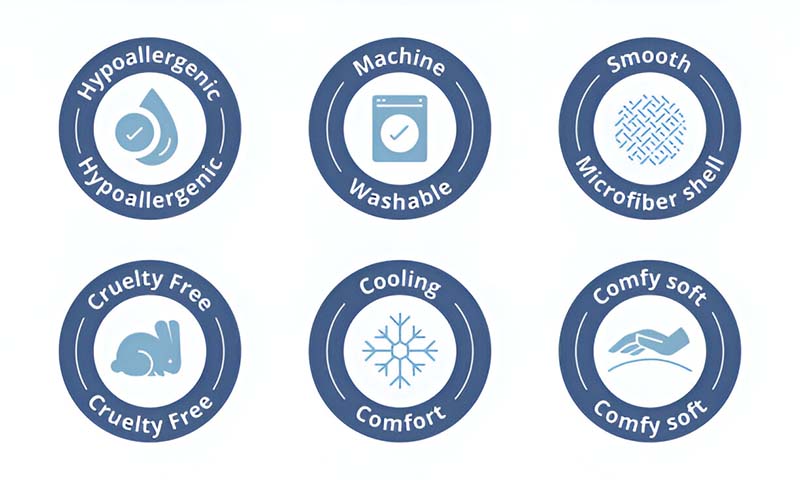Finding a comfortable night's sleep while sneezing and coughing in time can be difficult for allergy sufferers. Popping antihistamines before bed might seem like an obvious answer, but there is more to this. Hypoallergenic bedding, especially pillows, may help.
Hypoallergenic pillows help reduce nighttime exposure to common allergies. Made with anti-dust mite, mold, and other allergen-resistant materials, these pillows offer a place to escape the elements while keeping you wide awake. With the rising popularity of hypoallergenic pillows, many are switching to them to get a more comfortable and less sneezy sleeping experience with anti-allergen pillows.
So, if you wake up congested and with itchy eyes, maybe checking out the best hypoallergenic pillows is your next step to getting better sleep and more peaceful nights.
What is a Hypoallergenic Pillow?
A hypoallergenic pillow minimizes the risk of allergic reactions by reducing or preventing exposure to common allergens. These pillows are typically made from materials that are less likely to harbor or attract allergens such as dust mites, mold, and animal dander. A hypoallergenic pillow aims to provide a cleaner, more comfortable sleeping environment for those with allergies or asthma.
Allergen-Resistant Materials: Crafted from materials that reduce allergen buildup.
Dust Mite Resistance: Includes tightly woven covers to block dust mites.
Antimicrobial Treatments: Contains treatments to inhibit bacteria and mold growth.
Easy to Clean: Often machine washable for easy maintenance.
Why Do We Need Hypoallergenic Pillows?

After two years of use, up to 10% of pillows' weight can consist of dust mites, their feces, and various types of bacteria and molds. Studies by Airmid Health Group revealed that all examined used pillows contained bacteria, including Staphylococcus aureus, known for causing infections ranging from skin issues to severe sepsis.
Additionally, 50% of these pillows harbor molds like Aspergillus, which can trigger allergies and asthma, alongside fungi such as Candida, which are responsible for topical infections. Hypoallergenic pillows can prevent exposure to common allergens such as dust mites, mold, and pet dander—which is primarily a concern if you have allergies. They are constructed with products that do not retain as much dirt and allergens as a regular duck down or synthetic fiber pillow.
Hypoallergenic pillows reduce allergen buildup and remove stimulants that cause respiratory illness, making sleep more restorative. In addition, they are easier to wipe down after spills and wind dust with less exposure to allergens. The bottom line is that hypoallergenic pillows are the best way to prevent allergic reactions and achieve restful sleep, making them a top recommendation for hypoallergenic bedding.
Types of Hypoallergenic Pillows
There are several types of pillows available, each designed to cater to different preferences and needs:
- Natural Latex Pillows: These are made from latex derived from rubber trees. Latex pillows are naturally resistant to dust mites and mold, making them hypoallergenic. They provide excellent support and bounce-back characteristics.
- Organic Cotton Pillows: Pillows made from organic cotton are free from pesticides and chemicals that can trigger allergies. Organic cotton pillows are breathable and comfortable, suitable for sensitive skin or allergies.
- Bamboo Pillows: Bamboo pillows are often filled with shredded memory foam or bamboo fibers. Bamboo has natural antimicrobial properties and is resistant to dust mites and mold. It is also breathable and hypoallergenic.
- Hypoallergenic Down Alternative Pillows: These pillows are filled with synthetic materials designed to mimic the softness and loft of down feathers without triggering allergies. They are often made from polyester fibers or microfiber clusters.
- Silk Pillows: Silk is naturally hypoallergenic and resistant to dust mites. Silk pillows are luxurious, smooth, and breathable, making them a good choice for allergy-sensitive individuals.
- Microfiber Pillows: Microfiber pillows are made from the finest synthetic fibers that are hypoallergenic and resistant to dust mites. They are soft, lightweight, and easy to care for.
- Memory Foam Pillows with Hypoallergenic Covers: Memory foam pillows can be hypoallergenic if their covers are made from hypoallergenic materials like bamboo or organic cotton. Memory foam is not always hypoallergenic but can be made with the right cover.
Benefits of Hypoallergenic Pillows
Pros |
Cons |
|---|---|
| Ideal for allergy sufferers | May be more expensive than regular pillows |
| Helps reduce exposure to allergens | Limited variety compared to regular pillows |
| Often made from natural or synthetic fibers | Some may find them less comfortable |
| Resistant to dust mites and mold | Requires regular cleaning to maintain efficacy |
| Can improve sleep quality for sensitive individuals | Effectiveness varies depending on the material |
Hypoallergenic pillows have several significant advantages, particularly for people who are allergic to or sensitive to common allergens:
Allergen Resistant
Hypoallergenic pillows are made from materials less likely to retain allergens like mildew, dust mites, and pet dander. This decrease in allergens improves general health by reducing allergy reactions and respiratory problems while you sleep.
Improved Air Quality
Hypoallergenic pillows improve indoor air quality in the bedroom by reducing the accumulation of allergens. This is especially crucial for allergy patients, as allergen contact can cause symptoms like congestion, sneezing, or watery eyes.
High Comfort
Many hypoallergenic pillows are cozy and firm, ensuring a peaceful night's sleep without interruptions. They are made of diverse materials and forms to accommodate a range of sleeping preferences and provide the best possible comfort for each user.
Durable
Hypoallergenic pillows are frequently composed of premium, long-lasting, and strong materials. Over time, they hold their support and form, offering enduring comfort and allergy protection.
Easy to Clean
The majority of hypoallergenic pillows are simple to clean and maintain. They include washable covers or machine washable to help keep them free from allergens and preserve hygiene.
Versatile
Hypoallergenic pillows come in various forms and materials, such as natural latex, organic cotton, bamboo, and synthetic down substitutes. People can select a pillow from this assortment that best suits their tastes and unique allergy requirements.
Peace of Mind
People with allergy-sensitive members can rest easily, knowing their loved ones use hypoallergenic pillows. It makes sleeping in a more pleasant and calm atmosphere possible by easing the concern about being exposed to allergens while you sleep.
How to Choose the Best Hypoallergenic Pillows?
The first thing we consider when selecting a hypoallergenic pillow is the material and whether or not it inhibits dust mites from penetrating the content. Another crucial component is the filler; you should always ensure it is easily cleaned. If it will be your primary sleeping pillow, you must purchase a pillow that allows you to add or remove filling. This refers to the pillow's zipper situation and, in the case of larger pillows, whether the filling is inside the pillow or is covered separately.
Final Thoughts
Hypoallergenic pillows minimize exposure to allergens, including mildew, dust mites, and pet dander, and significantly improve health. Reducing allergic reactions and respiratory problems enhances general well-being and sleep quality. Their use promotes better indoor air quality and creates a cozy, peaceful sleeping environment, making them a wise decision for preserving health, particularly those who are allergic to specific allergens.














